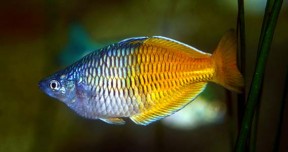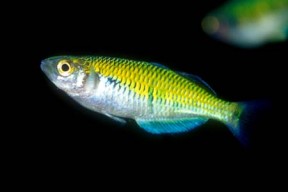Melanotaenia boesemani
Boeseman's rainbowfish
Classification
Melanotaeniidae
Distribution
Indonesia.
Habitat
Has a very limited natural range, being known only from an area of three lakes known as Ajamaru, in the remote Vogelkop Peninsula of Irian Jaya, and from nearby Lakes Hain and Aitinjo. The rainbows tend to congregate in the clear shallows of the lakes, where aquatic vegetation grows very densely. The lakes are characterised by hard, alkaline water (pH 8.0-9.0), although the fish are also found in some surrounding tributaries with wildly different water chemistry (pH 6.0-6.5).
Maximum Standard Length
Males to 4.4″ (11cm), females to 3.2″ (8cm).
Aquarium SizeTop ↑
An active species requiring an aquarium measuring at least 48″ x 12″ x 12″ (120cm x 30cm x 30cm) – 110 litres.
Maintenance
This species, like most rainbows, looks most at home in a planted aquarium. Provide areas of dense vegetation, along with some open areas for swimming. Other decor is not particularly important. The choice of plants should reflect the slightly hard, alkaline conditions preferred by the fish. Filtration and tank maintenance should be very efficient to encourage the male fish to develop their spectacular colouration.
Water Conditions
Temperature: 81-86°F (27-30°C). Strictly a tropical species.
pH: 7.0-8.0. It will not do well in soft, acidic conditions.
Hardness: 10-20°H
Diet
Unfussy and will accept most dried, frozen and live foods. Regular feedings of the latter will help to ensure the fish exhibit their best colours.
Behaviour and CompatibilityTop ↑
Very peaceful, but can disturb smaller or slow-moving fish with its rapid movements and relatively large size. Good tankmates include other similarly-sized rainbowfish, characins, danios, barbs, and catfish such as Corydoras. It can also be kept with many species of Rift Lake cichlid, due to its water requirements.
Boesman’s rainbowfish can be quite skittish and do far better when kept in a shoal of at least 6-8, preferably more. The males will also be encouraged to display their best colours in the company of conspecifics. Obviously a suitably-sized aquarium would be required for a very large group.
Sexual Dimorphism
Mature males are larger and exhibit brighter colouration than females. They also develop a much deeper body than females as they grow.
Reproduction
As with other members of the genus, this is not a difficult species to breed, being an egg scatterer, although the fry can prove somewhat tricky to raise. The breeding aquarium should be at least 30″ long, and contain slightly hard, alkaline water with a pH of around 7.5 and a temperature of 80-84°F. A small air-powered filter will provide sufficient oxygenation and flow. The tank should be filled with fine-leaved plants such as java moss, or nylon spawning mops. No substrate is necessary.
The adult fish are best conditioned in a group in a separate aquarium, with plenty of live and frozen foods. As the fish come into condition, the females will appear noticeably plumper, and males will display to each other almost constantly. Select the fattest, best-coloured pair for spawning and introduce them to the spawning tank. A small raise in temperature can often induce spawning. The pair will spawn for a period of several weeks, laying batches of eggs each day. These are attached to surfaces by a small thread. Although the adults tend not to eat the spawn, it’s easier to raise the fry in a separate aquarium, so we recommend checking the plants or mops regularly and removing any eggs you find to a raising tank containing water from the spawning tank.
The eggs hatch in 7-12 days, depending on temperature, and the tiny fry initially require infusoria–type food, before graduating onto free swimming foods, such as brine shrimp nauplii, after a week or so. Sinking foods are unsuitable as the fry tend to stay very close to the water surface.
NotesTop ↑
This uniquely-patterned species is one of the most popular rainbowfish in the hobby and can be found swimming in most dealers’ tanks. However, virtually all these fish are mass-produced on fish farms in the Far East and Eastern Europe. M. boesmani is actually quite rare in nature, and is on the IUCN red list of endangered species. Unfortunately this is one species on which the aquarium trade has had a massively detrimental effect, with an estimated one million fish a year being collected to provide breeding stock for the trade.
If you want to buy some of these rainbows, don’t look for the fish in these pictures! Adult specimens are rarely seen, and it’s the much drabber juvenile fish that are almost always offered for sale. However, exercise some patience (even on a good diet, full colour development can take over 12 months), and you will be rewarded with what is surely one of the most stunning tropical freshwater species available in the hobby.




November 23rd, 2014 at 3:55 pm
One of the things that several rainbowfish enthusiasts have found is that the majority of species including M.boesemani fare better long term in cooler environments between 22-24c and not the high 27-30c quoted above. Breeding, egg incubation, hatching and fry rearing is better in the higher temp range.